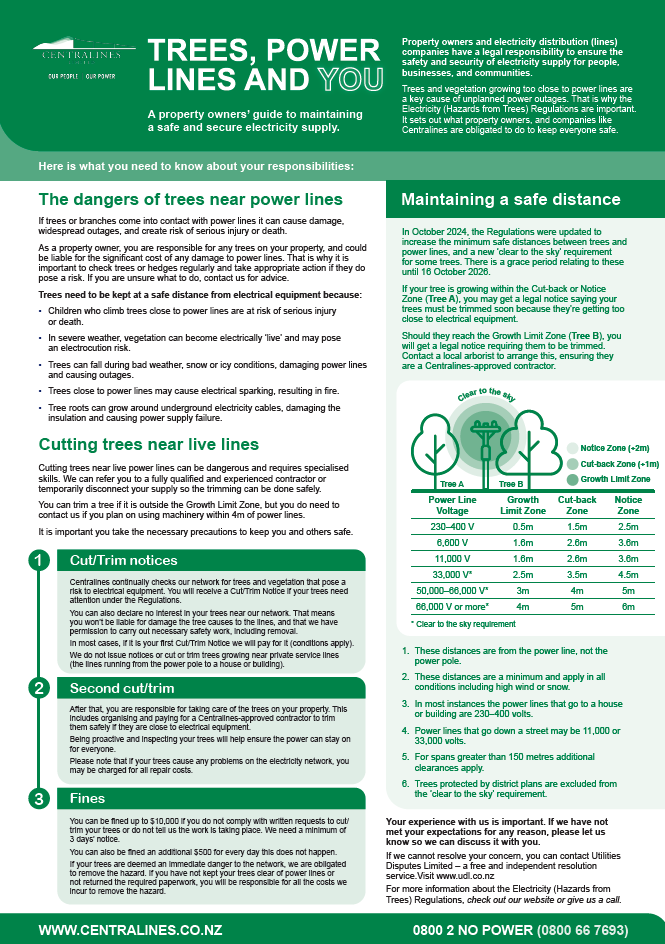Safety and trees
Property owners are legally required to ensure their vegetation, such as trees, hedges, vines and plants, does not grow too close to power lines.
The Electricity (Hazards from Trees) Regulations 2003 were introduced by the Government to protect public safety and ensure a reliable electricity supply.
What's new?
In October 2024, the regulations were updated to increase the minimum safe distances between vegetation and power lines, and introduced a new ‘clear to the sky’ requirement for some trees. Learn more about the updates here.
Trees near power lines are dangerous for a number of reasons:
- Electrocution: Touching, trimming or climbing vegetation too close to power lines puts you at risk of severe electric shock.
- Power outages: Overgrown vegetation can cause power outages, especially during storms.
- Fire: Electrical currents running through power lines can sometimes cause fires, particularly when wires come come into contact with branches.
Keeping your vegetation at a safe distance helps protect your property, the community, and the electricity network.

The regulations
The regulations outline that tree owners are responsible for having their trees trimmed when they grow too close to the power lines. Electricity network providers, like Centralines, are responsible for issuing notices to tree owners when their tree(s) are growing too close to our network power lines.
The Electricity (Hazards from Trees) Regulations 2003 apply to:
- Electricity network lines: they do not cover service lines (that run from the network in the street to a house or building).
- All trees and vegetation (whether on private or public land): which are growing into network power lines, unless they are covered by a previous agreement.
The regulations are designed to protect public safety and electricity supply by:
- Specifying safe distances (growth zones) from network lines which trees must not encroach.
- Setting rules about who has responsibility for cutting or trimming trees that encroach on electricity network lines.
- Assigning liability if those rules are breached; providing an arbitration system to resolve disputes between electricity network lines owners and tree owners about the operation of these regulations.
Complying with the regulations
Electricity network providers and tree owners must comply with the requirements of the regulations and are both liable for financial penalties if they fail to comply.
Tree owners must comply with a notice to cut or trim a tree in the time stated, to avoid a fine of up to $10,000 and any additional costs if electricity lines or equipment are damaged by a tree.
Centralines is committed to complying with the regulations to keep our network safe. Where tree owners fail to comply with a cut or trim notice we will escalate the matter to Energy Safety.
Dispensation
Tree owners are entitled to request dispensation from a notice to cut or trim a tree. However, under the regulations, trees must be kept clear of the growth limit zone.
When a tree owner requests dispensation, Centralines will arrange for a professional arborist to check if the tree is inside the growth limit zone and any other safety issues required by the regulations. Once Centralines receives the results of this inspection, we will fully consider the request and a formal response will be sent within four weeks.
Arbitrators
The Minister of Economic Development is responsible for appointing arbitrators to hear and determine disputes between tree owners and network owners.
The regulations allow a tree owner to contact an arbitrator in the case of a dispute if:
a) The network owner has refused to grant a dispensation which the tree owner believes should have been granted;
or
b) A dispensation has been granted but the tree owner does not agree with its terms.
Every effort should be made to resolve disputes that don't qualify for tree arbitration that arise between the tree owner and the works owner around the Electricity (Hazards from Trees) Regulations 2003.
Disputes which are unable to be resolved can be referred by the owner to http://www.utilitiesdisputes.co.nz/
